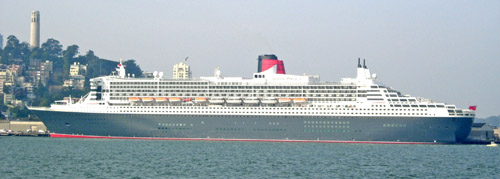Mayor Gavin Newsom and San Francisco port officials are protesting a proposed rule by the federal Homeland Security Administrationís Department of Bureau of Customs and Border Protection (CBP) that threatens San Franciscoís core cruise business: Alaska, Pacific Northwest and Mexico cruises.

Photo by Joel Williams
By Paul Duclos
Published: March, 2008
The port estimates that 39 cruise calls each year are at risk, resulting in the loss of $45 million in direct spending by cruise lines and passengers.
At a time when our nation is on the brink of recession, the federal government should be stimulating our economy. This rule would strike a blow to our cityís successful cruise business, said Newsom.
Currently, foreign-flagged passenger vessels (or flags of convenience) that visit more than one U.S. port per itinerary must stop at a port outside the U.S. to be in compliance with the Passenger Vessel Services Act of 1886. Cruise ships sailing from San Francisco to Alaska and the Pacific Northwest stop in Canadaóat Vancouver or Victoriaóto comply with the 122-year-old law. Last November, the agency proposed an administrative rule that would require these vessels to stop for at least 48 hours at each foreign port, even though most calls today are for eight hours or less.
In his letter to the federal government, Newsom wrote, The cruise industry provides significant employment in San Francisco. Our analysis shows that the proposed rules as drafted would reduce our homeport calls by more than 40 percent and our passengers by more than fifty. An estimated 7,500 longshore job assignments are at risk for the local dock workers, who handle passenger baggage and load the shipís provisions.
RFP Issued for Pier 96 Marine Cargo Terminal
And while the port is actively courting the cruise industry, it has not given up entirely on cargo. Indeed, it recently issued a Request for Proposals (RFP) from qualified respondents for the leasing and operation of a marine cargo terminal at the Portís Pier 96 Maritime Terminal.
The site is comprised of approximately eighteen acres of paved land located in the portís Southern Waterfront on Pier 96, within the portís 278-acre Piers 80-96 Maritime Industrial Complex. Pier 96 was previously used as a container handling facility.
The site enjoys some of the best industrial transportation access in San Francisco, with easy access to water, road, and rail transport. The site is adjacent to the portís bulk cargo terminals at Piers 92-94 and the portís freight rail facilities, with direct on-dock rail access on two sides.
The portís breakbulk facility is located across Islais Creek at Pier 80. The location is close to Interstate 280 and Route 101, as well as to major local truck routes. The port will select a qualified operator that has the demonstrated ability to operate a marine cargo terminal operation on the site, with the goal of negotiating a lease or management agreement for the site.
Asian Cargo Seeks Alternative Destinations
San Francisco Bay ferry commuters have long recognized the need for more government investment in infrastructure. But the regionís retail and manufacturing community may be in even more desperate need for bayside improvements.
Just ask Douglas A. Tilden, CEO of Ports Group America, which is the parent company of Marine Terminals Corporation. In a recent speech at the California Maritime Academy in Vallejo, he warned that Americaís lack of a clear national transportation policy, coupled with land-use and environmental challenges, makes it almost inevitable that some of the projected surge in Asian cargo volume over the next decade will begin flowing through ports in Mexico and Canada rather than the U.S. West Coast.
Tilden blamed the problems the United States is facing on several factors: Overall, I think weíve lost the political will to build new port capacity and the rail and highway infrastructure that must go with it. Local politicians complain they see little of the economic benefits of a port locally, but field all the complaints about the congestion and pollution they generate.
Second, he said, there simply is no national transportation policy. I can sit down with the transportation minister of a country like Mexico and get the big picture about their plans. Iíd have to wade through 20 different agencies in Washington to get the same information.
Tilden also blamed what he called environmental Balkanization: There are so many conflicting local, state and regional environmental regulations that it is hard for companies to make rational use of their assets. We want to be good stewards, but we face a welter of different local and regional regulations just on what fuels we can use for operationsÖpropane, liquid natural gas or bio-diesel.

